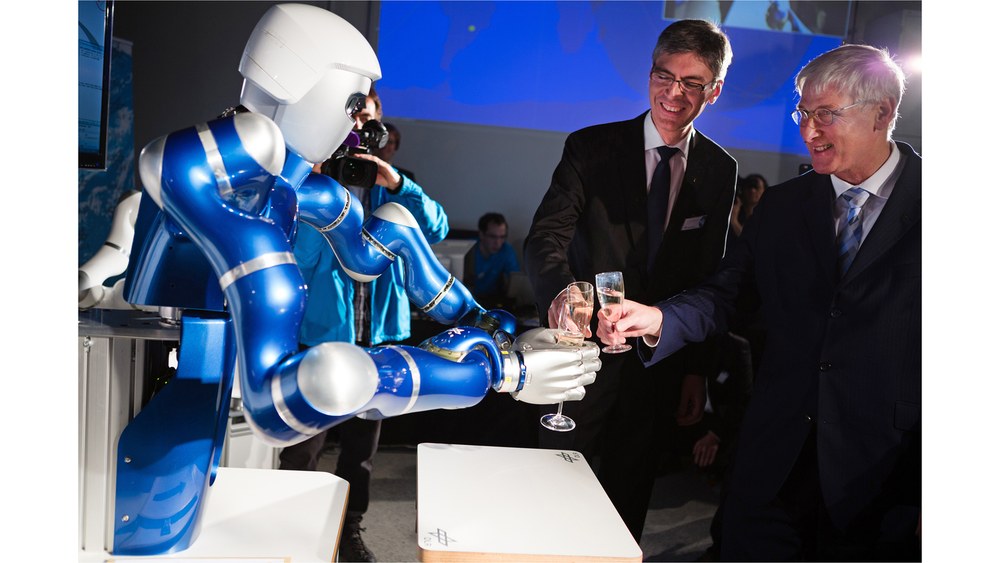"Tele-handshake" between ISS and Earth

A simple gesture of greeting and yet extraordinary: a handshake between an astronaut on the International Space Station and scientists at the German Aerospace Center (DLR). This interaction was undertaken by means of the DLR humanoid robot SpaceJustin located in Oberpfaffenhofen and remote controlled on December 17, 2015 from the International Space Station. The cosmonaut Sergei Volkov on the ISS and DLR institute director Professor Alin Albu-Schäffer on earth could see one another, speak with one another and – thanks to force feedback – feel the force and motion of the handshake.
"The technological Kontur-2 experiment is another success by DLR in robotics. For the first time, force feedback was implemented between an astronaut in orbit and a person on earth using a humanoid robot," said Pascale Ehrenfreund, Chair of the DLR Executive Board. "The scientific results of this project offer a broad spectrum of applications ranging from planetary exploration to terrestrial applications in telemedicine and telepresence in critical situations." Telepresence systems enable people to act across great distances via a robotic "avatar" while feeling as though they are on site.
Unattained complexity
A humanoid robot has never before been controlled from space. SpaceJustin’s arm was controlled and received force feedback with the Kontur-2 joystick, which has been on board the International Space Station since July 2015 and was developed by the Institute of Robotics and Mechatronics. The uniqueness of the technology and the experiment lie in their previously unattained complexity. Using the space grade joystick on the ISS, it is possible to transmit sensitive force feedback to the astronaut in real time. An additional operating element of the joystick closes the robotic hand, enabling the astronaut to even grasp an object.
ISS - St. Petersburg - Oberpfaffenhofen
One of the greatest challenges for telepresence applications in space travel is the time lag during data transmission. At a distance of about 400 kilometers, the delay is approximately 30 milliseconds. For this, a special control scheme ensures that the delay does not generate unsteady behavior that might cause the system to swing upwards. The force feedback during the tele-handshake at the DLR functioned so well that the scientists were able to conduct another demanding experiment:
While ISS crewmember Volkov remotely controlled SpaceJustin’s right arm, the Russian State Scientific Center for Robotics and Technical Cybernetics (RTC) in St. Petersburg controlled the robot’s left arm. The RTC has an identical Kontur-2 joystick from the DLR and was linked in from its lab in St. Petersburg. Together, Volkov and RTC used SpaceJustin to grasp a ball and hand the ball to the DLR team in Oberpfaffenhofen, which coordinated the procedure. All three participants were able to feel the contact forces of the others: the pressure against the ball while grasping and the letting go when handing over the ball.
Robonaut of the future
Telepresence technologies will be indispensable in future space travel. From a space station, astronauts would, for example, be able to control a robot exploring Mars or the moon while carrying out tasks requiring fine motor skills. Maintenance and repairs on satellites can also be carried out using telepresence from the ground.
The tele-handshake and the collaborative pass of the ball marked the climax of the “Kontur-2” series of experiments that optimized and tested telepresence technology on the ISS. Following the successful demonstration of this technology, the DLR Institute of Robotics and Mechatronics is ready to take the next step: telepresence control can also be transferred to operating systems with more than two degrees of freedom in the future. This enables control in any direction and paves the way for a new stage in aerospace telepresence robotics. More complex tasks are possible in the future: the astronaut will not only be able to control the arm and hand of SpaceJustin, but the entire body of a humanoid robot.
